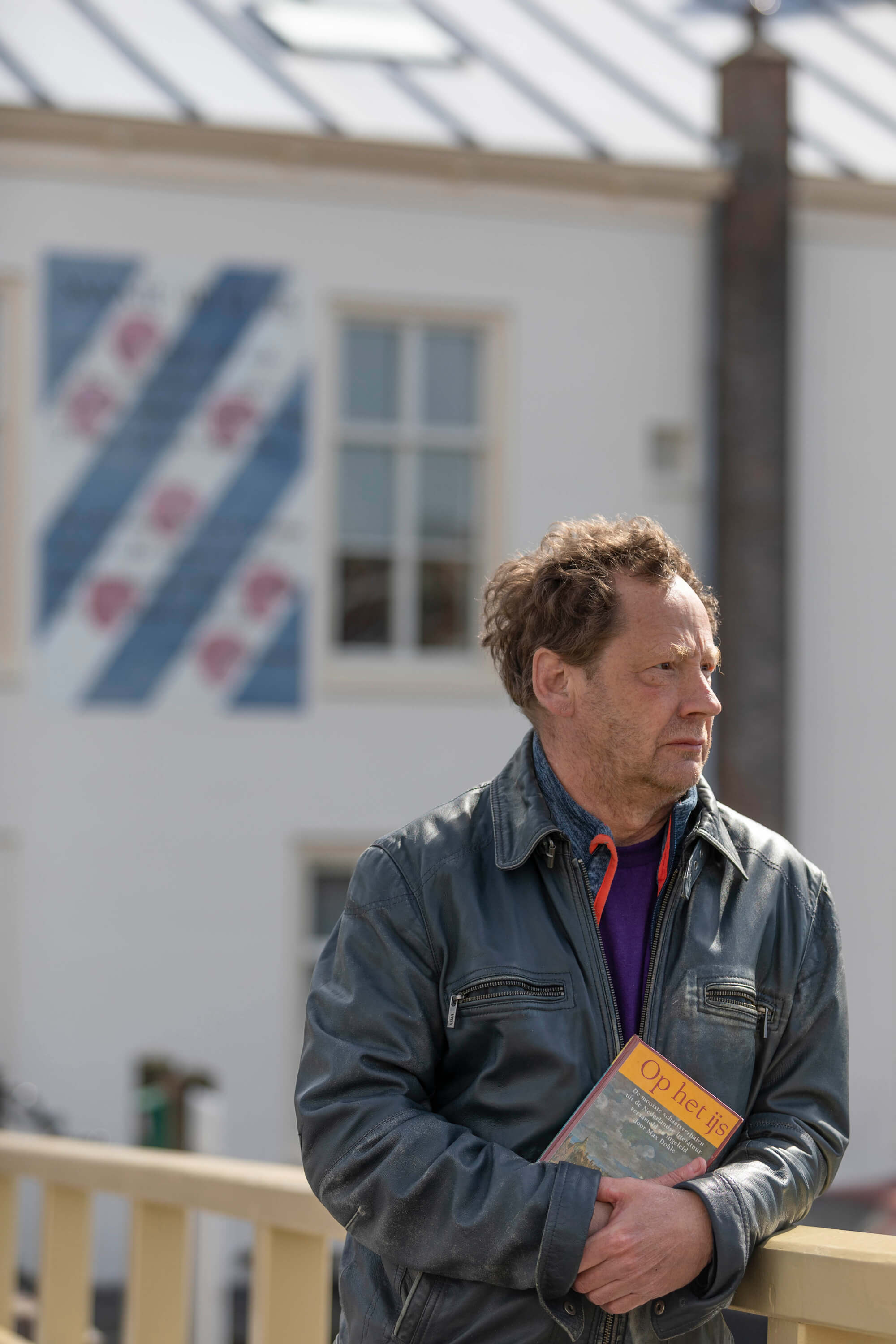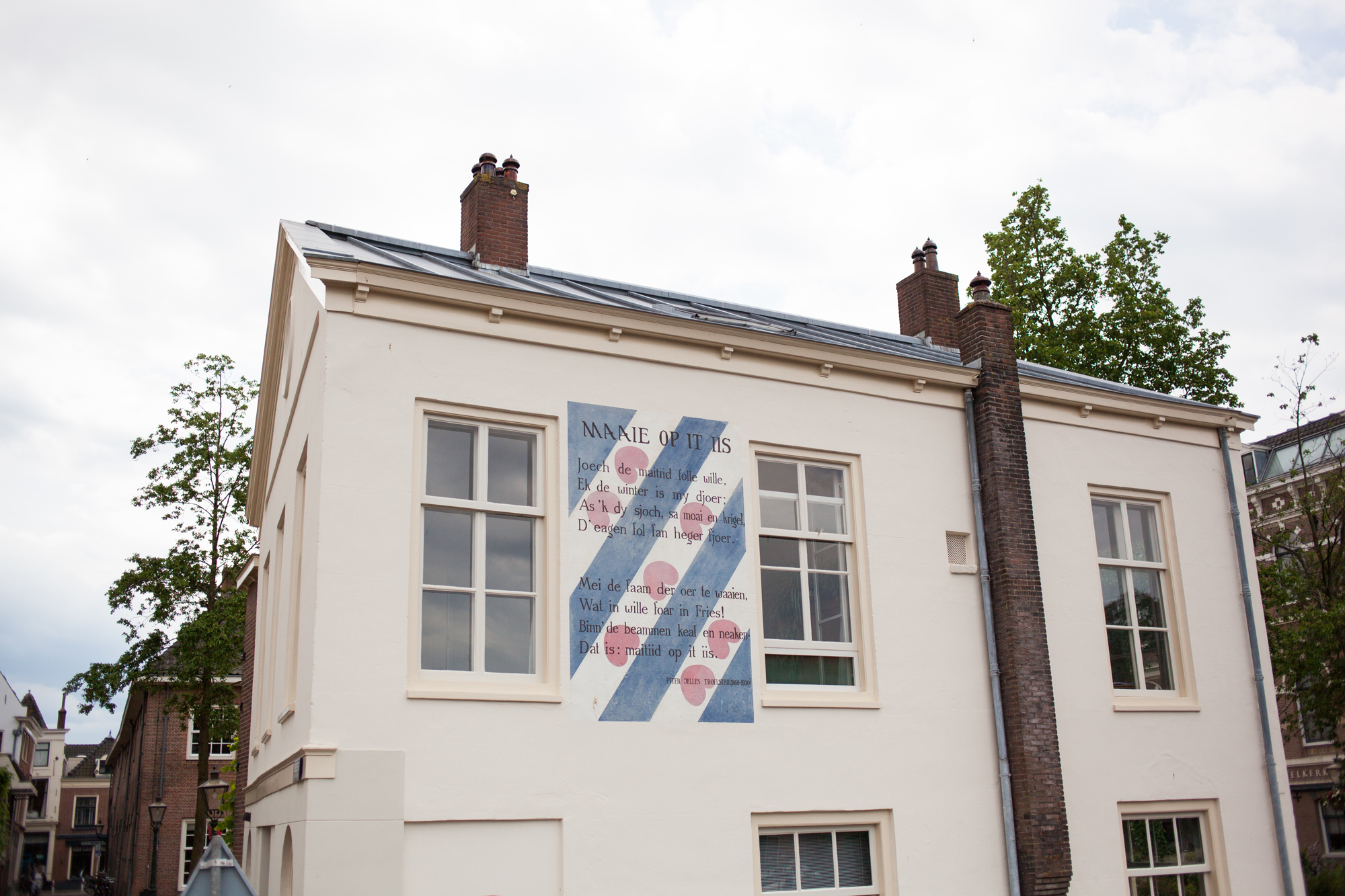Maaie op it iis (1882)
Pieter Jelles Troelstra
When the temperature drops below freezing point, the Frisians start to feel butterflies. Not because of love, but because of ice-skating fever. When the waters have frozen over, people are finally able to skate outside, which is just as thrilling as the arrival of Spring.
Mei op het ijs
Mocht de lente vreugde geven,
Ook de winter is me duur;
Als 'k jou zie, zo mooi en dapper,
D' ogen vol van hoger vuur.
Met zijn meisje weg te zwieren
Voor een Fries het paradijs!
Als de bomen kaal en naakt zijn
is het: lente op het ijs.
Vertaald door J. Veenbaas
Listen to this poem in Frisian.
Voiced by: Douwe Breimer
This poem in 60 seconds
For decades, Pieter Jelles Troelstra was one of the most well-known Dutch politicians. However, before he dedicated his life to social-democracy, he was captivated by the Frisian language. In his early twenties, he published a collection of beautiful pieces of Frisian writing and could not resist making a contribution himself. What could be more suitable than this poem, in which he describes what ice-skating means to the Frisians?
Want to know more? On this website you can listen to the poem, discover its origins and its author and find out what the poem means to the people of Leiden.
Pieter Jelles Troelstra
Leeuwarden 1860 - Den Haag 1930
The sword of poetry
His biographer Piet Hagen writes, “Pieter Jelles doesn’t want to make ‘art for art’s sake’, but wants to put his poetry in service of a better world.” His poetry makes a contribution to the world, his poetry is the poetry of the people. The poet, according to Troelstra’s poem De sjonger en de wrâld (The poet and the world) has to be in service of “the large questions”; to encourage goodness in man and create an earthly paradise for everyone:
Enter the world! Fight with the sword of poetry;
The voice of truth will rise from your heart,
You will show the lost the path to Good
And establish the realm of Love and Harmony!
Translation: Demi van de Wetering
A better world
Pieter Jelles Troelstra did not only enter the history books as a poet, but also as a politician. As an attorney, he was confronted with injustice and exploitation in the Frisian countryside, and was captivated by socialism. For decades, he was the party leader of the Sociaal-Democratische Arbeiderspartij (SDAP; Social-Democratic Labour Party) and an eminent member of the Dutch House of Representatives.
Fanatic
Troelstra was a passionate politician and advocate of the Frisian people, which he remained until his death. His political career, however, ended late November 1918. Back then, he propagated the liberation of the working class. This was an extreme position to take, especially as violent revolutions were happening in Germany and Imperial Russia. Although his political role was over, he remained an icon for the social-democrats and the Frisian movement.
What's this poem about?
Fever
In the poem, Troelstra captures the Frisian spirit. When the temperature drops below freezing point, the Frisians start to feel butterflies. Not because of love, but because of the ice-skating fever. When the waters have frozen over, people are finally able to skate outside, which is just as thrilling as the arrival of Spring.
Maaie
The Frisian poem has an ambiguous title, which proves to be difficult to translate. Mainly, “maaie” is the Frisian word for the month May, but in a broader sense, it could also mean Spring. However, it is also commonly used in the context of ice-skating: which resembles, according to some, the maaien (swinging) of the arms and legs.
In the first and the final line of the poem, the word maitiid is used; which translates as Springtime or simply Spring. It thus is time to mow (maaien) the grass. Again, there are multiple interpretations: it is time to swing (maaien) the arms and legs! And if there is also a nice girl to maaie (ice-skate) with, as if it is maaie (Spring)... Ice-skating fever and butterflies. The poem plays around with the ambiguous meaning of the Frisian word maaie.
Origin story
Pieter Jelles Troelstra presumably wrote this poem in 1881, when he was twenty-one years old and was still enjoying a classical education. During this period, he was captivated by the Frisian language. Although his family was well-off and therefore spoke Dutch at home, young Troelstra searched for Frisian-speaking contemporaries, who encouraged and distributed their language and culture as well. In 1881, together with a like-minded peer, he compiled the collection It jonge Fryslân (Young Friesland) in which the works of a large number of young Frisian poets and writers were collected. Maaie op het iis (May on ice) is also included.
Stories from Leiden
From the Rembrandtbrug, Max Dohle pensively looks out over the Galgewater. Behind him is the reconstructed lever-barrier booth, once the port warden’s residence. In 2004, Max took the initiative to realize a wall poem about ice skating. It is the only Leiden wall poem in Frisian. Max writes about sports history, particularly about ice-skating. The Galgewater is Leiden’s best skating spot. Almost as beautiful as the Frisian lakes, thinks Max. Troelstra wrote Maaie op it iis (on the ice in May) at the end of the nineteenth century. Max dreams of severe winters. He has never been able to skate the Galgewater in May. A century ago, it was around 8°C on average in spring. Now it’s 10. But those are the temperatures of Holland. In Friesland, it’s always colder in winter. And Frisians are no Leideners. Frisians keep going, even on thin ice. And in their flag, the red lily leaves (pompeblêden) and sloping lines are positioned differently: like hearts on an ice-skating rink.

Photography: Patricia Nauta
Text: Joop van Gerven
Share your story
Does this poem hold a special place in your heart? For example, do you remember when you first read the poem? Or did you come across it someplace unexpected? Let us know at muurgedichten@taalmuseum.nl! We would love to add your story to our website.
Peter Jelles Troelstra in Leiden

Photo Anoesjka Minnaard
This poem was painted on the wall in 1999 when a Frisian family lived in the house. The house used to belong to the director of the former Maritime Academy, which was located close-by in Rembrandtpark. Below the poem, there is a signature of a little jackdaw. Leiden-born Max Dohle, an ice-skating and poetry enthusiast was allowed to choose the poem. Dohle is German for jackdaw.
Ice-skating in Leiden
The wall poem overlooks the Galgewater, where the Oude Rijn and the Nieuwe Rijn converge and the Rhine will run towards Katwijk, where the river discharges into the sea. Here, in past cold winters, people were able to skate in and out of the city. The Galgewater has been a popular ice-skating spot throughout the ages. A painting of Jabes Heenck, named IJsvermaak op het Galgewater (Ice-fun on the Galgewater) can be found in museum De Lakenhal, which is located nearby. It is likely that the young Rembrandt skated on the Galgewater. The house in which he was born was located here in the Weddesteeg.
Troelstra and the Frisian character
Frysk bloed, tsjoch op! / Wol no ris brûze en siede!
En bûnzje troch ús ieren om!
Frisian blood, come on! / It wants to bubble and boil!
And roam through our veins!
These are the opening lines of the Frisian anthem. Frisian blood flows more strongly through the veins when the ditches and ponds have frozen over. And when there is ice in Friesland, all the Dutch people start to suffer from the ice-skating fever and begin to hope for the Elfstedentocht; an ice-skating marathon in Friesland, where participants skate past eleven cities and over nearly 200 kilometers. The poem does not just describe a winter’s day, but also the joyous expression of Frisian character. Troelstra’s contributions to Frisian literature indicate his close connection to the Frisian language and culture.
Fun facts
- Even though he lived outside Friesland for a large part of his adult life, Pieter Jelles Troelstra spoke Frisian at home with his wife and children.
- After the unveiling of this wall poem, there was some quarreling about the design. The Frisian flag had been rotated ninety degrees to the right. Due to this, the pompeblêden (the red lily leaves) were almost upside down. Some Frisians thought this to be too impudent. According to painter Jan Willem Bruins, the flag was simply painted as if it were hanging straight down.
Maaie op it iis
Joech de maitiid folle wille,
Ek de winter is my djoer;
As 'k dy sjoch, sa moai en krigel,
D' eagen fol fan heger fjoer.
Mei de faam der oer te waaien,
Wat in wille foar in Fries!
Binn' de beammen keal en neaken-
Dat is: maitiid op it iis.
May on the ice
Should spring bring joy,
Also winter I admire
As I see you, fair and spirited,
Eyes filled with higher fire.
With his girl gliding across
For a Frisian, this is paradise!
As the trees are bare and exposed,
This is: springtime on the ice.
Translation: Demi van de Wetering
Learn more
This entry was written by Het Taalmuseum in collaboration with Joris D. Raven. The translation into English is by Demi van de Wetering. The following publications were consulted:
- Hagen, Piet, Politicus uit hartstocht. Biografie van Pieter Jelles Troelstra (Amsterdam 2010).
- Schepers, J. Troelstra als Fries dichter (Amsterdam 1925).
- Troelstra, P.J., It jonge Fryslân. Sangen en Rimen fen Jonge Fryske Skriuwers byenoar brocht troch P.J. Troelstra en O.H. Sytstra. Heerenveen 1882.
- Idem, Fen Liet en Libben. Lezing voor het Haagse gezelschap Rjucht en Sljucht. Den Haag 1910.
- Idem, Gedenkschriften. Amsterdam 1931.
- Idem, Samle Fersen. Leeuwarden 1981.
- P.J.Troelstra’s revolutionaire rede in 1918, via parlement.com.
- Vertalingen uit De sjonger en de wrâld, Fen Liet en Libben en het Frysk Folksliet door Joris D. Raven.
- Interview met Max Dohle door Joris D. Raven, d.d. 27 november 2017.
